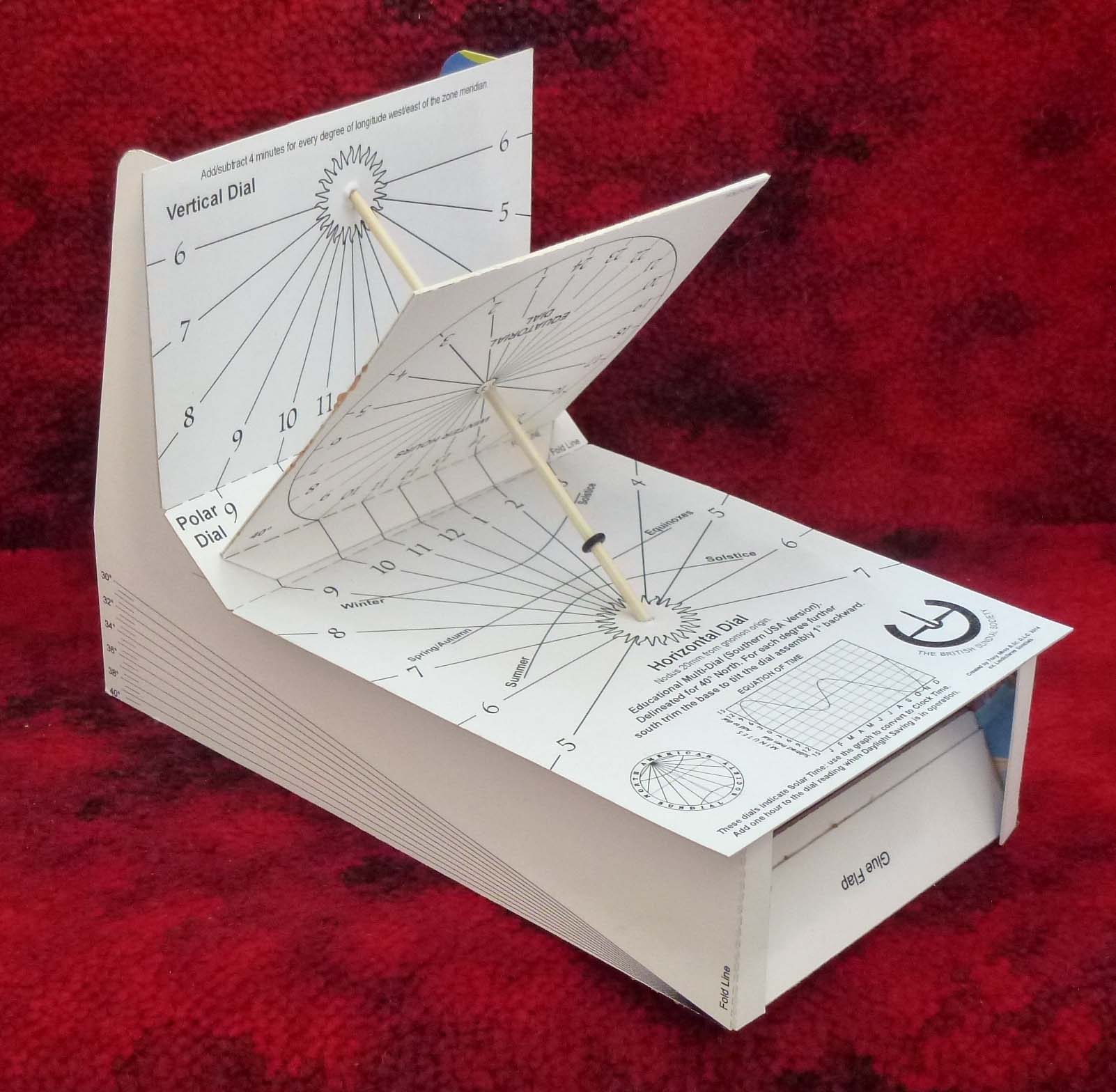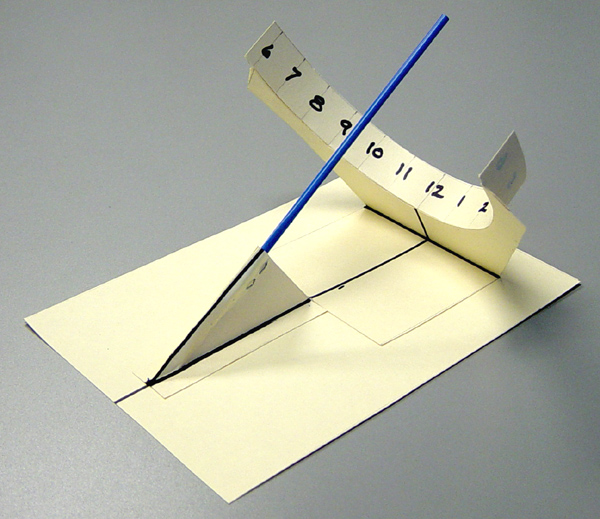- Details
- Hits: 11660
John Krieger, a former science teacher, is a strong supporter of STEM in the classroom and science in the real world. Bollards at Laguna Nigel in southern California might offer the opportunity to teach a bit of astronomy.

John says, "I don’t mean to imply that every concrete curb stop should be turned into an astronomical instrument. But why can’t we have more of these things around us? The ‘globe sundial’ is not an original idea of mine. People have actually made them, but they are depressingly rare....Sometimes someone does go to the trouble of making a beautiful, scientifically literate public display, and places it in full view of the everyday public, and even provides instructions..."  Many of these public displays are sundials and during John's career, he developed aids to teach astronomy to schoolchildren. At his website, he makes an array of paper sundials, globes, astrolabes and quadrants available in PDF form for printing and easy constructing to make an accurate sundial or globe with explanation of how it works. "Most of them are printable PDF files that you can download and give to kids to label, cut out, and use as the basis of some activity... Officially, I am making all of these works available under a Creative Commons — Attribution License, which means you may do anything you like with them, as long as you give me credit as the creator."
Many of these public displays are sundials and during John's career, he developed aids to teach astronomy to schoolchildren. At his website, he makes an array of paper sundials, globes, astrolabes and quadrants available in PDF form for printing and easy constructing to make an accurate sundial or globe with explanation of how it works. "Most of them are printable PDF files that you can download and give to kids to label, cut out, and use as the basis of some activity... Officially, I am making all of these works available under a Creative Commons — Attribution License, which means you may do anything you like with them, as long as you give me credit as the creator."
And don't worry about adjusting for latitude. His paper instruments are available for download at every 10 degrees of latitude from 60 deg south to 60 deg north, which for example would be appropriate for use in Reykjavik, Iceland. In North America, 20 degrees covers lower Florida, 30 degrees is suitable for southern California, 40 degrees works for the big US east coast cities, and 50 degrees is appropriate for Calgary in the heart of Alberta.
Downloads available at: https://www.astronomyforthinkers.com/downloads/
For the Hemispherical Dial, go to: https://www.instructables.com/A-Hemispherical-Paper-Sundial/
- Details
- Hits: 13363
 Carl Sabanski is a sundial enthusiast who has made paper cut-out sundial kits that can be tailored to your latitude in either the Northern or Southern hemisphere. He presents a wide variety of sundials, all of which will tell accurate local solar time. His dials come in many types: Equatorial, Equatorial Ring, and Gnomon-less Equatorial Sundials, Horizontal Sundials, Polar and Cycloid Polar Sundials, Cross and Star Sundials, Analemmatic Sundials, a fantastic sundial made from a CD disk and a Digital Equatorial Sundial based on the patent of Thew. There are Ring Dials, a Globe Dial based on the dial of Thomas Jefferson, and much, much moret source simulated the sun.
Carl Sabanski is a sundial enthusiast who has made paper cut-out sundial kits that can be tailored to your latitude in either the Northern or Southern hemisphere. He presents a wide variety of sundials, all of which will tell accurate local solar time. His dials come in many types: Equatorial, Equatorial Ring, and Gnomon-less Equatorial Sundials, Horizontal Sundials, Polar and Cycloid Polar Sundials, Cross and Star Sundials, Analemmatic Sundials, a fantastic sundial made from a CD disk and a Digital Equatorial Sundial based on the patent of Thew. There are Ring Dials, a Globe Dial based on the dial of Thomas Jefferson, and much, much moret source simulated the sun.
Each of these sundials is illustrated with a 3-dimensional drawings to show assemblyh and use. PDF files at his site present the detailed sundial design that can be cut or folded specifically for your latitude.
Pick up your sundial at: https://www.mysundial.ca/sdu/sdu_sundial_kits.html
- Details
- Hits: 22786
What can 62 LEGO bricks build? An equatorial sundial. A recent dial building project demonstrates a very nice looking sundial dial built from regular LEGO elements. The design is a classic equatorial sundial using a central north-pointing rod gnomon with shadow cast only hourly segments tilted at 15 degree increments. The base swivels such that it can be adjusted for any latitude.
The building blocks use 1xN plates placed side by side on the underside of a 1x4x5 arch, creating the hourly progression of 15 degree tilted tiles. In the design shown, two blue plates in the center bracket the noon mark. Outer blue plates indicate 6am and 6pm. All you need to do is paste on the hour numerals.

It appears that a number of different sundials can be created using LEGO tiles. A comment on the shown design is that "after some experimenting, I think the base needs to be extended by two stud lengths. The center of gravity shifts a little too far when the dial is adjusted for lower latitudes. It still stands, but is tippy."
In fact, there is a whole world of LEGO sundials. Check out http://62bricks.com/category/sundials where you'll find more equatorial sundials, a vertical east-west sundial, and a polar dial. It's amazing what you can do with LEGOS
- Details
- Hits: 16211
 Tony Moss of the British Sundial Society has designed a paper cut-out dial that combines a horizontal dial, a vertical dial, and a polar dial all into a nice assembly made from 4 print-outs and gluing together cereal box cardboard. This unique instrument introduces you to the shadow relationships of these fundamental typesof sundials. A challenging but rewarding design.
Tony Moss of the British Sundial Society has designed a paper cut-out dial that combines a horizontal dial, a vertical dial, and a polar dial all into a nice assembly made from 4 print-outs and gluing together cereal box cardboard. This unique instrument introduces you to the shadow relationships of these fundamental typesof sundials. A challenging but rewarding design.
Dial layout and detailed instructions are provided for three latitude zones: 30-40°, 40-50°, and 50-60° covering areas from the southern USA to Alaska, Canada, UK, Europe, Russia, China, Korea, and Japan.
- Details
- Hits: 22952
 Need a small sundial for your display or science project? Want to show how different sundials cast shadows? Need a simple cut-out science exercise for your students? Fabio Savian of Milan Italy has the solution. For a number of years he has managed the Sundial Atlas website, ever increasing the number of sundial photos from around the world. Over the last several years he has worked very hard to create the gnomolab that includes a solar compass map of the earth, cloud software for creating analemmatic (human shadow) sundials, and a section for making paper sundials to your specification. The analemmatic dial measurements and papger dial designs are created as download PDF files. Four of those dials were created by the North American Sundial Society. Enjoy. Sundial Atlas Paper Sundials
Need a small sundial for your display or science project? Want to show how different sundials cast shadows? Need a simple cut-out science exercise for your students? Fabio Savian of Milan Italy has the solution. For a number of years he has managed the Sundial Atlas website, ever increasing the number of sundial photos from around the world. Over the last several years he has worked very hard to create the gnomolab that includes a solar compass map of the earth, cloud software for creating analemmatic (human shadow) sundials, and a section for making paper sundials to your specification. The analemmatic dial measurements and papger dial designs are created as download PDF files. Four of those dials were created by the North American Sundial Society. Enjoy. Sundial Atlas Paper Sundials
- Details
- Hits: 14127
 The North American Sundial Society is developing sundial material for the earth-science curriculum, particularly for middle school teachers to focus on the sky and the earth’s place in the solar system and to use the sun to show daily and seasonal changes.
The North American Sundial Society is developing sundial material for the earth-science curriculum, particularly for middle school teachers to focus on the sky and the earth’s place in the solar system and to use the sun to show daily and seasonal changes.
NASS offers a set of horizontal cut-out paper sundials for your latitude. Freely make copies for yourself and your students.
Download your sundial here:
- Details
- Hits: 15094
 Second-grade students at Connetquot Elementary School in Islip, New York, created sundials using paper plates and pencils. The pencil gnomons were set mostly vertical by the students and then they traced the resulting shadows at three times during the day. This helped teachers Leslie Davis and Melissa Love demonstrate the sun’s apparent movement in the sky and talk about the earth's rotation as the cause. "The students really had fun," said Love, "and they were able to recognize that a sundial is a tool that can be used to measure time."
Second-grade students at Connetquot Elementary School in Islip, New York, created sundials using paper plates and pencils. The pencil gnomons were set mostly vertical by the students and then they traced the resulting shadows at three times during the day. This helped teachers Leslie Davis and Melissa Love demonstrate the sun’s apparent movement in the sky and talk about the earth's rotation as the cause. "The students really had fun," said Love, "and they were able to recognize that a sundial is a tool that can be used to measure time."
- Details
- Hits: 32053

This Sundials for Starters appeared in The Compendium in June, 2007
by Robert L. Kellogg, Ph.D.
In this day and age of computers, I began musing what is one the least complicated sundial to build. In the last Compendium I showed the classical method of graphically constructing a horizontal dial, and the introductory NASS Sundial CD discs contain power point presentations for creating a variety of sundials. Here is a simple equatorial dial that I’ve used in sundial demonstrations. It requires several pieces of cardboard and a coffee stirrer.
- Details
- Hits: 13186
 Avid dialist and former The Grammar School teacher and head of the Putney, VT school, Mac Oglesby guides 6th graders to plan and construct their own working sundials. Oglesby's students learned how to correctly position their dials to display the accurate time throughout the year.
Avid dialist and former The Grammar School teacher and head of the Putney, VT school, Mac Oglesby guides 6th graders to plan and construct their own working sundials. Oglesby's students learned how to correctly position their dials to display the accurate time throughout the year.
